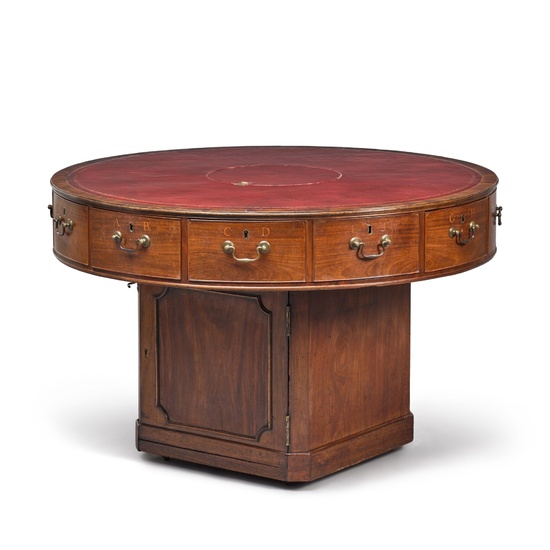A George III mahogany 'rent' drum table, circa 1770
the rotating top with a lidded central reserve and now with a later gilt-tooled red leather top, above eight short and two long lettered drawers to the frieze, secured to the square pedestal with a sliding catch, the base fitted with a cupboard containing a shelf, with concealed brass castors
73.5cm. high, 118cm. wide; 2ft. 5in., 3ft. 10½in
Condition Report:
This table has undergone restoration and has been repolished. Later leather with some minor scuffs and scratches. Stains to crossbanding, notably above the drawer N-O, and some filler to this border. Patched repairs at sites of previous handles. Drawers with remedial attention which includes filler to splits and pitting. Drawer fronts generally with historic wear. Some lifting/buckiling to moulding below drawer N-O. The locks replaced throughout. Some patching and fillet repairs around the escutcheon to cupboard door and vertical patch to the angle which has the latch to secure the top. Old marks and scratches throughout.
Catalogue Note:
This table conforms to a popular late 18th century type, sometimes described as a 'rent' table, the lettered drawers allowing for the alphabetical arrangement of important estate papers. The present example omits the letters J and U, bringing the number of drawers to a neater total of 12 instead of 13. The decision to miss out these letters in particular should be seen in the context of the high levels of literacy in Latin amongst the aristocracy and gentry of the eighteenth century, given that Classical Latin does not differentiate between I and J, nor U and V (thus the name 'Julius' tended to be written as 'IVLIVS').
For related examples, see the drum table from the Collection of Ambassador and Mrs. Felix Rohatynold, sold Sotheby's New York, 21 October 2020, lot 211 and the table formerly in the collections of the Barons Monson, sold Sotheby's London, 29 April 2014, lot 21.
Provenance:
Probably Probably Sir Nicholas Bayly, 2nd Bart. (1709–1782) or his son Henry Bayly-Paget, 1st Earl of Uxbridge (1744–1812).
View it on
Estimate
Time, Location
Auction House
the rotating top with a lidded central reserve and now with a later gilt-tooled red leather top, above eight short and two long lettered drawers to the frieze, secured to the square pedestal with a sliding catch, the base fitted with a cupboard containing a shelf, with concealed brass castors
73.5cm. high, 118cm. wide; 2ft. 5in., 3ft. 10½in
Condition Report:
This table has undergone restoration and has been repolished. Later leather with some minor scuffs and scratches. Stains to crossbanding, notably above the drawer N-O, and some filler to this border. Patched repairs at sites of previous handles. Drawers with remedial attention which includes filler to splits and pitting. Drawer fronts generally with historic wear. Some lifting/buckiling to moulding below drawer N-O. The locks replaced throughout. Some patching and fillet repairs around the escutcheon to cupboard door and vertical patch to the angle which has the latch to secure the top. Old marks and scratches throughout.
Catalogue Note:
This table conforms to a popular late 18th century type, sometimes described as a 'rent' table, the lettered drawers allowing for the alphabetical arrangement of important estate papers. The present example omits the letters J and U, bringing the number of drawers to a neater total of 12 instead of 13. The decision to miss out these letters in particular should be seen in the context of the high levels of literacy in Latin amongst the aristocracy and gentry of the eighteenth century, given that Classical Latin does not differentiate between I and J, nor U and V (thus the name 'Julius' tended to be written as 'IVLIVS').
For related examples, see the drum table from the Collection of Ambassador and Mrs. Felix Rohatynold, sold Sotheby's New York, 21 October 2020, lot 211 and the table formerly in the collections of the Barons Monson, sold Sotheby's London, 29 April 2014, lot 21.
Provenance:
Probably Probably Sir Nicholas Bayly, 2nd Bart. (1709–1782) or his son Henry Bayly-Paget, 1st Earl of Uxbridge (1744–1812).



